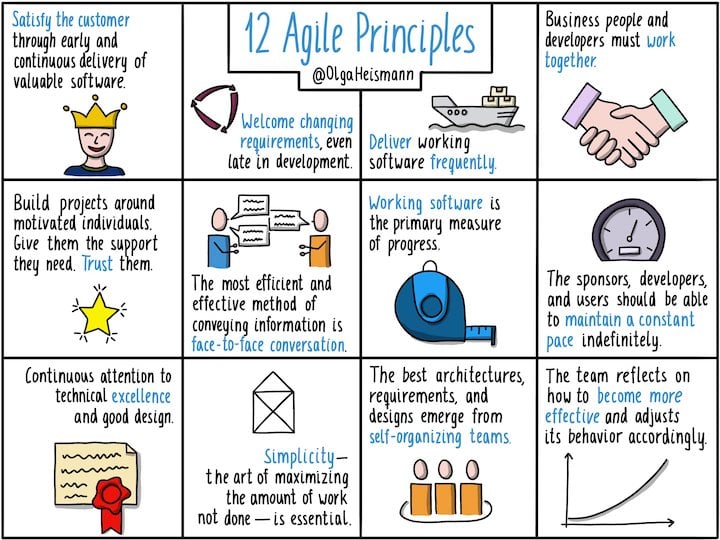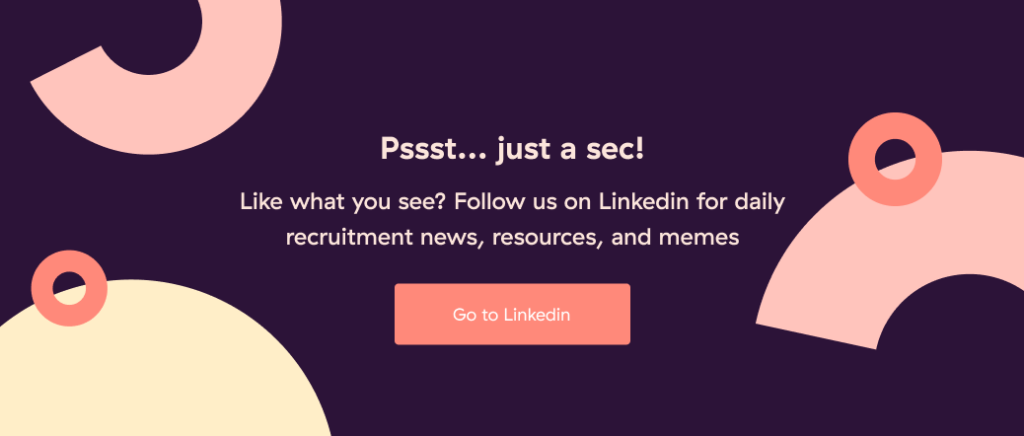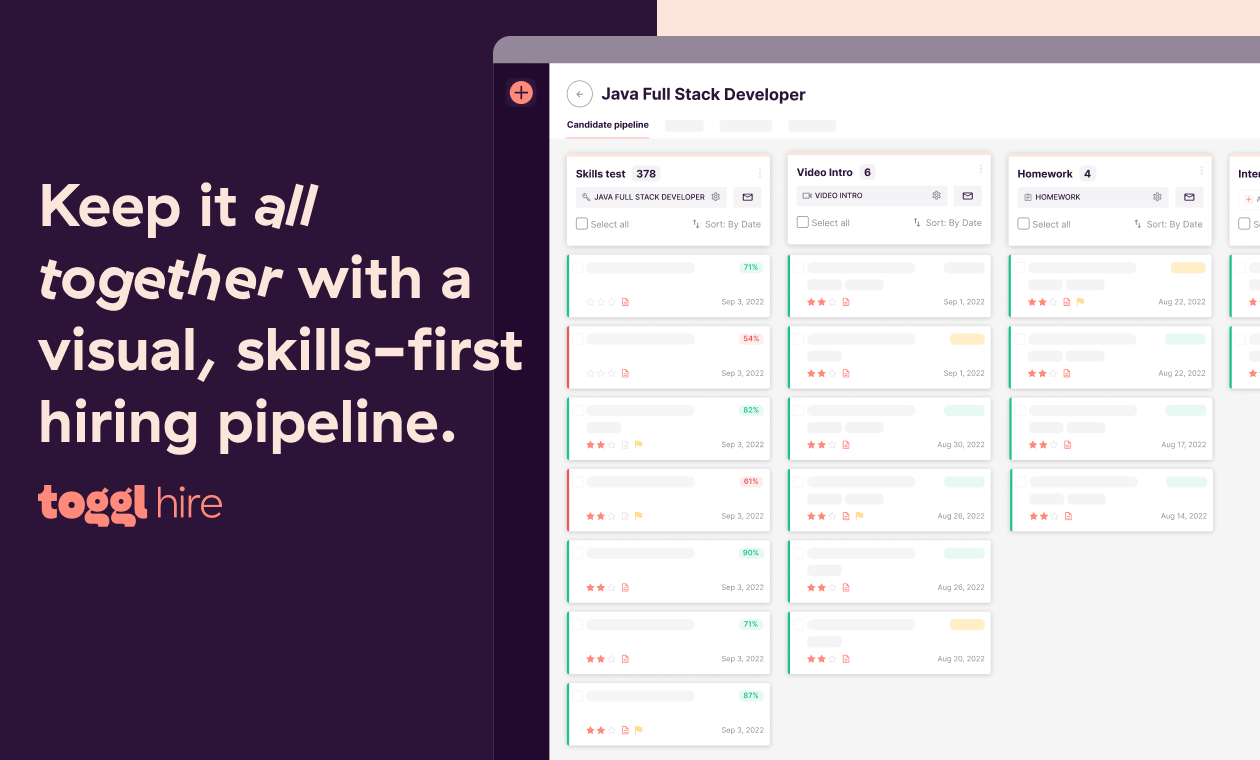If you spend time around software development teams, you’ll have heard the term “agile”. At its core, Agile is an approach to working where processes are broken down into iterations, which are completed with a focus on people, communication, and change – while it works great for software development, it also works for other industries, including agile recruiting.
And with companies that optimize their job recruitment process by shortening their hiring cycles by 60%, an agile recruiting process is a great way to boost your recruitment team’s performance. In this article, we’ll cover all things agile recruitment, including how you can implement it in just 5 easy steps.
The Agile Methodology and Agile Recruiting – The Definition & Background
To understand agile recruiting, we have to start with the roots of the agile methodology, which was founded in 2001.
Until then, traditional software development methods were slow, working on a product until every single aspect was completed without customer input. As a result, organizations were late in delivering value to their customers, with the actual customer needs often changing by the time working software was actually released.
In 2001, 17 developers came together and developed the agile approach. This approach was underpinned by several agile methodologies, values, and principles, some of which are covered in the images below.


In essence, the agile method emphasizes the following key areas when building a software product.
- Iterative workflows break projects into smaller tasks, each creating value that builds up over time.
- Team members work together collaboratively in a self-organized way.
- Teams work more closely with their customers, creating tight feedback loops to discuss what works and doesn’t.
- As well as breaking work into smaller tasks, teams also work in short cycles (known as sprints) of 2-4 weeks to continually set objectives and monitor progress.
In short, the agile methodology was created to accommodate rapid changes, flexibility, and continuous improvement – all things that translate well to teams in other industries, including recruitment teams.
Agile is a great way to take your recruitment strategy to the next level by building candidate-centricity, real-time feedback, and team communication into your recruiting process. In a world where recruitment is becoming increasingly digital and fast-paced, it pays to give your recruiting team all the tools to do their roles as quickly and effectively as possible.

The Benefits of an Agile Recruitment Process
But what does Agile recruiting actually do for you and your team? Let’s take a quick look at some of the benefits.
The benefits of agile help recruiters build stronger relationships with hiring managers, improve the candidate experience, and iteratively work towards their talent acquisition goals.
That might seem like a pretty broad statement, but when you break it down, it’s easy to see how that happens:
- Agile workflows are built on regular interactions with the key stakeholders for your project/initiative. In recruitment, imagine the benefits you can gain from having regular short interactions with your hiring managers, candidates, and upper management.
- One of the key principles in agile is to satisfy the customer. If you focus more heavily on your candidates, it won’t be long until your candidate experience improves. There are many supplementary benefits here for your agile recruiting process, too, by bringing your recruitment team closer to your candidates and hiring managers.
- The core ethos of agile is to bring team members closer together in a way that is empowering, autonomous, and collaborative. When you have a happier, more engaged recruitment team, you’ll start to see better outputs as your team members deliver stronger results for their hiring managers and fully implement your recruitment strategy.
The Challenges of Implementing Agile Recruiting
But unfortunately, implementing agile recruitment isn’t always straightforward. There are a lot of adjustments that team members need to make to start to reap the benefit of agile working.
Here are some of the challenges you’ll need to overcome:
- The biggest challenge is getting teams to adopt an agile mindset. Rather than focusing on delivering the ‘perfect‘ solution, agile focuses on learning and improving continuously while looking for fast ways to make progress.
- Teams also need to get used to a faster way of working, with team members having to work in sprints, regularly track progress against KPIs, and absorb constant updates to their process. It can sometimes be hard to see how the wider recruitment strategy will develop when working at such short intervals, but that’s where leaders need to set the vision and drive the team forwards bit by bit.
- Lastly, it can be hard for stakeholders, especially your hiring manager, to buy into agile recruitment as it’ll change the way they work too. You’ll need to take time to teach them the benefits of agile, explain how the recruitment process will change, and agree on key metrics to jointly measure your performance.
5 Tips for You & Hiring Managers to Ease into Agile Recruiting
So, now that we’re clear on the benefits and challenges of adopting agile recruitment, it’s time to get into how to actually do it. Here are 5 tips to help you re-shape your recruitment process to start to see the benefits of agile.
#1 – Split up your hiring efforts into sprints
Much like developing an app, recruiting takes time. The average time to fill a role is 42 days. By day 42, your needs as the recruiter may have changed greatly compared to day 1, which is why it’s useful to work in short weekly or 2-weekly sprints instead of one long clunky process.
For example, let’s say you put out an ad for a React developer and agree that within the first week, you’d like to take at least 2 candidates straight through to interview to test the entire process. This may help quickly realize that the job ad is attracting the wrong kind of candidates and that it needs extensive changes. With agile recruiting, you’ll spot this failure after a week instead of waiting 3/4 weeks to get to this point with a traditional process.
Moreover, this gives everyone in the hiring team a chance to stop and look at the kind of candidates you’re getting before moving on. You could realize that after the screening period, you’re not getting the kind of candidates you need, and you can go back to square one.
#2 – Have Standup Meetings with the Hiring Manager & Recruitment Team
Another major part of the agile method is keeping the team up to date with what everyone is doing. This is usually done in the form of a quick daily standup meeting where everyone in the team takes turns to update on three things:
– What they did since the last meeting
– What they are about to do
– The challenges/blockers they’re currently facing
Unlike regular meetings, these “standup” meetings are fast, lasting no longer than 15 minutes. Usually, everyone would co-locate and stand up somewhere to create good team energy. But, with hybrid working, these are now commonly done over video calls, but all the same rules apply.
In agile recruiting, to make the most of these standups, you’ll want to involve other stakeholders too, such as an HR business partner, hiring manager, or finance lead. That way, everyone is aligned on where you are with each role and can help contribute to solving any problems.
These short meetings are crucial if you want to spot challenges quickly and correct them in time because, by day 42, it may be too late.
#3 – Set and Measure Your KPIs
Being flexible and fixing things as you go is one of the best features of the agile methodology. Of course, to know what’s going wrong, you first need to know what you’re measuring. The right way to go about it is to set some KPIs.
There is a range of hiring metrics that you can choose for your organization. More is not better in this case, so choose metrics that are relevant to your organization and the role you’re hiring for. Some examples of KPIs include:
– Cost per hire
– Time to hire
– Candidate job acceptance rate
– Application completion rate
With agile recruiting, pay attention to the metrics that can tell you what’s going wrong, such as the number of open positions and application completion rate. If you’re hiring using agile recruitment, if you measure these, you’ll be able to react quickly and makes changes before it’s too late.
#4 – Use Tools to Visualize Your Entire Hiring Pipeline
Similar to agile development, in agile recruitment, you need to leverage the power of technology to create visibility and collaboration around your recruitment process.
Visualizing your project, or in this case, your recruitment process, helps the entire team step back and see the progress from a bird’s-eye view. Again, this helps everyone engage with the agile recruitment concept, as they can see how the weekly sprint work contributes to the wider hiring process.

This is where Toggl Hire can help. Our skills-based hiring pipeline is the fastest, fairest, and leanest way of spotting and shortlisting great candidates. You can track and manage candidates from the job ad right through to the offer, with all of the team able to work together in a ‘kanban board’ style interface.
We bring together skills testing, video interviewing, and candidate scoring into one easy-to-use place, making Toggl Hire the single tool you need to master agile recruiting.
If you’d like to hear more, the best place to start is by watching our 2-minute explainer video below!
#5 – Prioritize Your Recruitment Process
When you create a new software product, your customers will often have feedback that could change the direction of your work. For example, in software development, customers may request a feature that they think would be great to have in the app. As long as the feature is viable to build, you’ll want to create it to make your product better for them.
For agile recruiting to be a success, it needs to follow the same ethos. You should continually engage with your customers (both the hiring manager and the candidate) to find out what’s working, what’s not working, and what could be improved. Get this right, and you’ll constantly improve your process to deliver stronger results.
To do this, you can use a good project management tool, such as Toggl Plan, with many teams opting to use something with a Kanban board view. That way, you can get a visual overview of where you are and where you’re headed with your hiring efforts and prioritize accordingly.
Wrapping up
Even though its original use is for software development, the agile methodology can be applied to many industries, including agile recruitment. If you’re working in fast-paced recruitment vertical, or you simply want to improve your recruitment process, agile recruiting could be a great solution for you.
No matter what type of role you’re hiring for, apply some of the agile principles above, and you’ll be well on your way to hiring better candidates, faster. And don’t forget, if you need a tool to help you, Toggl Hire is the perfect solution to create a simple and streamlined end-to-end hiring process!
James Elliott is an APMQ and MSP-certified project professional and writer from London. James has 8 years' experience leading projects and programs for tech, travel, digital, and financial services organizations, managing budgets in excess of £5m and teams of 30+. James writes on various business and project management topics, with a focus on content that empowers readers to learn, take action, and improve their ways of working. You can check out James’ work on his website or by connecting on LinkedIn.

